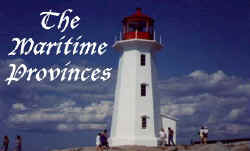 The Willey Travel Guide: Maritime Provinces (Part 4) - Lunenburg and the Annapolis Valley
Lunenburg: Lunenburg is an UNESCO World Heritage Site which was founded in 1753 by German, Swiss and Montbeliardian protestants. The community became known for its shipbuilding industry. The most famous of its fishing schooners was the "Bluenose". Built in 1921, the Bluenose was a four-time winner of international schooner races. In recognition of these achievements, the Bluenose is featured on the Canadian 10 cent coin.
Both the drive along highway 10 from Bridgewater to Middleton and the relatively short run down highway 101 bringing us to Annapolis Royal were uneventful. The town of Annapolis Royal is small but very pretty. We parked on St. George Street (which we did not know at the time is the oldest town street in Canada) and walked over to the Fort Anne National Historic Site. This site consists mainly of earthwork fortifications but also includes a museum and a powder magazine. The site does offer a wonderful view of the Annapolis River and, with lots of big shade trees, is a great spot for a picnic. We headed across the Annapolis River toward Port Royal. We passed the Annapolis Royal Tidal Power Generating Station which is the first of its kind in North America. While we did not visit the site there is an interpretive centre for those that wish to stop and see how they harness the power of the Fundy tides. As the oldest European settlement in the new world north of present day Florida we were unsure of what we would find at the Port Royal site, particularly after seeing Fort Anne. The Habitation, as it is known, is located near some private property on a relatively small piece of land. All we could see was this small walled structure and a small open sided hut, like a roadside vendor stand, which was the ticket office. We almost decided not to visit, however, I must say that we were pleasently surprised with by this site.
Marie is very adept at tole painting and we enjoyed seeing all of the projects she had done. One exceptional painting was the door to the bathroom next to the dining room (see photo). The next morning we watched a family of hummingbirds at the feeder while we ate our breakfast of sausage and eggs. |
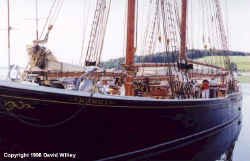 The Bluenose II, a replica of the original, is Nova
Scotia's "ambassador" making trips throughout the world. We had the
opportunity to explore the boat since it happened to be in its home port the day we
visited. The crew were very friendly and were more than willing to answer any
questions we had. The extent of workmanship in the boat was very evident as can be
seen in the photo at right. And above all, the visit is free!
The Bluenose II, a replica of the original, is Nova
Scotia's "ambassador" making trips throughout the world. We had the
opportunity to explore the boat since it happened to be in its home port the day we
visited. The crew were very friendly and were more than willing to answer any
questions we had. The extent of workmanship in the boat was very evident as can be
seen in the photo at right. And above all, the visit is free!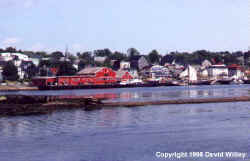 Lunenburg is also home to the Fisheries Museum of the
Atlantic (the red building in the photo at left). We spent about an hour in the
museum which provides interesting displays on the Atlantic fisheries industry.
Afterwards, we walked through the town which is filled with art, crafts and gift
shops. Our relatively tight schedule did not permit us to spend more than the
morning in the town before heading across to the Fundy shore and the Annapolis Valley.
Lunenburg is also home to the Fisheries Museum of the
Atlantic (the red building in the photo at left). We spent about an hour in the
museum which provides interesting displays on the Atlantic fisheries industry.
Afterwards, we walked through the town which is filled with art, crafts and gift
shops. Our relatively tight schedule did not permit us to spend more than the
morning in the town before heading across to the Fundy shore and the Annapolis Valley. 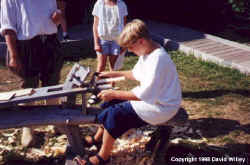 The structure is a reconstruction of the
original using the detailed drawings of Samuel de Champlain. The rooms are decorated
with copies of period pieces showing us how these early explorers lived. Costumed
guides provided additional insight. The displays were interactive and visitors were
allowed to try their hand at typical activities, such as shingle/shake making using the
tools of the day (see photo). You even get to keep the shake as a free souvenir.
The structure is a reconstruction of the
original using the detailed drawings of Samuel de Champlain. The rooms are decorated
with copies of period pieces showing us how these early explorers lived. Costumed
guides provided additional insight. The displays were interactive and visitors were
allowed to try their hand at typical activities, such as shingle/shake making using the
tools of the day (see photo). You even get to keep the shake as a free souvenir.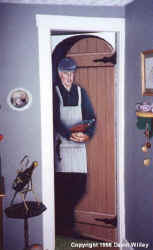 The old highway from
Annapolis Royal to Bridgetown was beautiful with many wonderful views of the winding
Annapolis river valley. Our "residence" this night was at Fundy Trail Farms (902-538-9481) located off the beaten track at a small
crossroads known as Burlington. The twin room ($40) and the house as a whole were
nicely appointed. Being out of the way means that there are no restaurant or other
facilities within walking distance. Our host, Marie, indicated that they were
considering closing the B&B business so call ahead if you are planning to visit.
The old highway from
Annapolis Royal to Bridgetown was beautiful with many wonderful views of the winding
Annapolis river valley. Our "residence" this night was at Fundy Trail Farms (902-538-9481) located off the beaten track at a small
crossroads known as Burlington. The twin room ($40) and the house as a whole were
nicely appointed. Being out of the way means that there are no restaurant or other
facilities within walking distance. Our host, Marie, indicated that they were
considering closing the B&B business so call ahead if you are planning to visit.